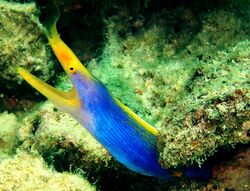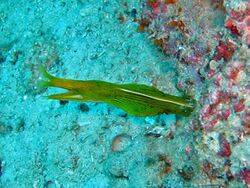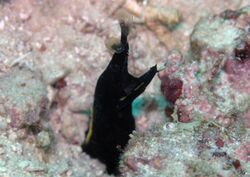Ribbon eel
Topic: Biology
 From HandWiki - Reading time: 3 min
From HandWiki - Reading time: 3 min
| Ribbon eel | |
|---|---|

| |

| |
| Male (above) and female (below) in Borneo | |
| Scientific classification | |
| Domain: | Eukaryota |
| Kingdom: | Animalia |
| Phylum: | Chordata |
| Class: | Actinopterygii |
| Order: | Anguilliformes |
| Family: | Muraenidae |
| Genus: | Rhinomuraena Garman, 1888 |
| Species: | R. quaesita
|
| Binomial name | |
| Rhinomuraena quaesita Garman, 1888
| |
| Synonyms | |
|
Rhinomuraena amboinensis | |
The ribbon eel (Rhinomuraena quaesita), also known as the leaf-nosed moray eel or bernis eel, is a species of moray eel, the only member of the genus Rhinomuraena. What is now known as R. quaesita also includes the former R. amboinensis. R. quaesita was used for blue ribbon eels and R. amboinensis for black ribbon eels, but these are now recognized as the same species. The ribbon eel is found in lagoons and reefs in the Indo-Pacific ocean, ranging from East Africa to southern Japan, Australia and French Polynesia.[1][2] This species is widely distributed and is frequently seen by divers in Indonesian waters with their heads and anterior bodies protruding from crevices in sand and rubble habitats from very shallow to about 60 m (200 ft).[3] Although generally placed in the moray eel family Muraenidae, it has several distinctive features leading some to place it in its own family, Rhinomuraenidae.[1]
The ribbon eel bears a resemblance to a mythical Chinese dragon with a long, thin body and high dorsal fins. The ribbon eel can easily be recognised by its expanded anterior nostrils. They are well known for their characteristic jaws that are frequently opened very widely when a diver approaches[3] Based on observed colour changes, it is generally considered a protandric hermaphrodite (first male, then changing sex to female), although this has yet to be confirmed.[2] Colour change related to sex change is not known from any other moray eel species.[2] The presumed juveniles and subadults are jet black with a yellow dorsal fin, in adult males the black is replaced by blue, and adult females are entirely yellow or yellow with some blue to the posterior.[2][4] The blue adult males range from 65 to 94 cm (26 to 37 in) in length, while the larger yellow females can reach up to 130 cm (51 in).[2][4] In captivity, the colour differences are not related to maturity or gender.[5]
In the aquarium
Because most ribbon eels do not live longer than a month in captivity,[citation needed] some[who?] feel that this species should never be purchased except for people with experience in keeping morays in captivity. Ribbon eels have been observed in many cases to stop eating after being captured, although there are reports of them surviving and eating in captivity for two years or more.[6][unreliable source?] Higher levels of success have been achieved in public aquaria, where there are a few reported cases of spawning at facilities in Europe and North America.[5]
Although captured for the aquarium industry, it remains common and widespread, and is not considered threatened.[1]
References
- ↑ 1.0 1.1 1.2 1.3 McCosker, J.E. (2010). "Rhinomuraena quaesita". The IUCN Red List of Threatened Species (IUCN) 2010: e.T155301A115297865. doi:10.2305/IUCN.UK.2010-4.RLTS.T155301A4770176.en. http://www.iucnredlist.org/details/155301/0.
- ↑ 2.0 2.1 2.2 2.3 2.4 Froese, Rainer and Pauly, Daniel, eds. (2015). "Rhinomuraena quaesita" in FishBase. April 2015 version.
- ↑ 3.0 3.1 Miller, M; Rutger, R (2013). "Observations of large muraenid leptocephali in coastal Indonesia: locations of sightings and behaviour of the larvae". Marine Biodiversity Records 6 (82). doi:10.1017/s1755267213000079.
- ↑ 4.0 4.1 Lieske, E., & Myers, R. (1999). Coral Reef Fishes. ISBN:0-691-00481-1
- ↑ 5.0 5.1 Preininger, D.; Halbauer, R.; Bartsch, V.; Weissenbacher, A. (2015). "First observations of fertilized eggs and preleptocephalus larvae of Rhinomuraena quaesita in the Vienna Zoo.". Zoo Biol. 34 (1): 85–88. doi:10.1002/zoo.21184. PMID 25385394.
- ↑ "My Blue Ribbon Eel eats! (pics and videos". Reef Central forums. http://www.reefcentral.com/forums/showthread.php?t=1050101.
- "Rhinomuraena quaesita". Integrated Taxonomic Information System. https://www.itis.gov/servlet/SingleRpt/SingleRpt?search_topic=TSN&search_value=635624. Retrieved 19 March 2006.
External links
Wikidata ☰ Q917209 entry
 |
 KSF
KSF


